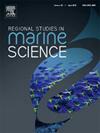The Heterobranchia gastropods from the Cabo Verde Islands (NE Atlantic): A hot-spot of endemism
IF 2.1
4区 环境科学与生态学
Q3 ECOLOGY
引用次数: 0
Abstract
The Archipelago of Cabo Verde is located in the northeastern Atlantic Ocean, off the coast of Senegal in West Africa. According to recent studies, it constitutes a distinct biogeographical subprovince with a subtropical affinity. The archipelago is well known for its high levels of marine endemism, likely due to the geological age and the isolation of the islands maintained by ocean currents and upwelling systems. In this paper, taxonomic findings from a field survey conducted on the islands of Sal, Boa Vista, and São Vicente are presented, accompanied by detailed geographical and ecological data to enhance the documentation of the distribution and habitat of species in the archipelago. Specimens were collected from tidal rock pools and subtidal zones down to 18 m depth through snorkeling and SCUBA diving. Sampling methods included direct hand collection, surface brushing, and gathering algae into sealed plastic bags for later examination. In the laboratory, specimens were sorted into morphospecies, photographed, cataloged, and preserved in 99 % ethanol following relaxation. A total of 27 species of Heterobranchia were identified, including one new record for the archipelago (Caloria quatrefagesi) and one species likely new to science (here identified as Facelinidae sp.). Notably, 44 % of the species collected are endemic to Cabo Verde, further highlighting the unique marine biodiversity of the region.
佛得角群岛(大西洋东北部)的异鳃腹足类:一个地方性的热点
佛得角群岛位于大西洋东北部,离西非塞内加尔海岸不远。根据最近的研究,它构成了一个具有亚热带亲和力的独特的生物地理副省。该群岛以其高度的海洋特有性而闻名,这可能是由于地质时代和洋流和上升流系统维持的岛屿隔离。本文介绍了在萨尔岛、博阿维斯塔岛和奥维森特岛进行的野外调查的分类结果,并附有详细的地理和生态数据,以加强对群岛物种分布和栖息地的记录。通过浮潜和水肺潜水,从18 m深度的潮岩池和潮下带采集标本。采样方法包括直接手工采集、表面刷刷和将藻类收集到密封塑料袋中供以后检查。在实验室,标本被分类成形态种,拍照,编目,松弛后保存在99% %乙醇中。共鉴定出27种异鳃目,包括群岛新记录的一种(Caloria quatrefagesi)和可能为科学新记录的一种(这里鉴定为Facelinidae sp.)。值得注意的是,收集到的物种中有44% %是佛得角特有的,这进一步突出了该地区独特的海洋生物多样性。
本文章由计算机程序翻译,如有差异,请以英文原文为准。
求助全文
约1分钟内获得全文
求助全文
来源期刊

Regional Studies in Marine Science
Agricultural and Biological Sciences-Ecology, Evolution, Behavior and Systematics
CiteScore
3.90
自引率
4.80%
发文量
336
审稿时长
69 days
期刊介绍:
REGIONAL STUDIES IN MARINE SCIENCE will publish scientifically sound papers on regional aspects of maritime and marine resources in estuaries, coastal zones, continental shelf, the seas and oceans.
 求助内容:
求助内容: 应助结果提醒方式:
应助结果提醒方式:


